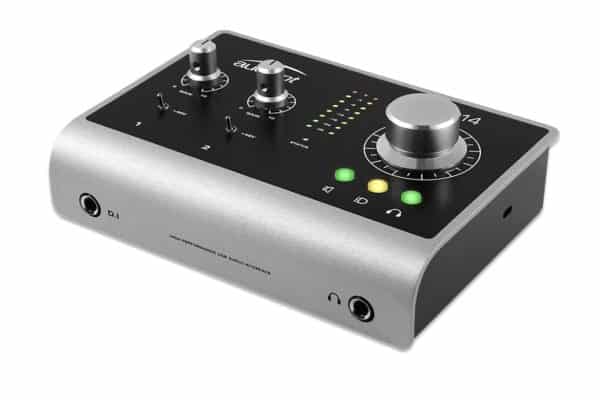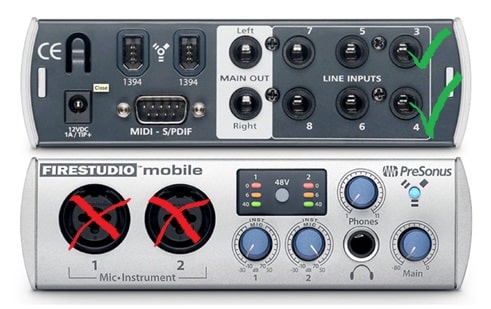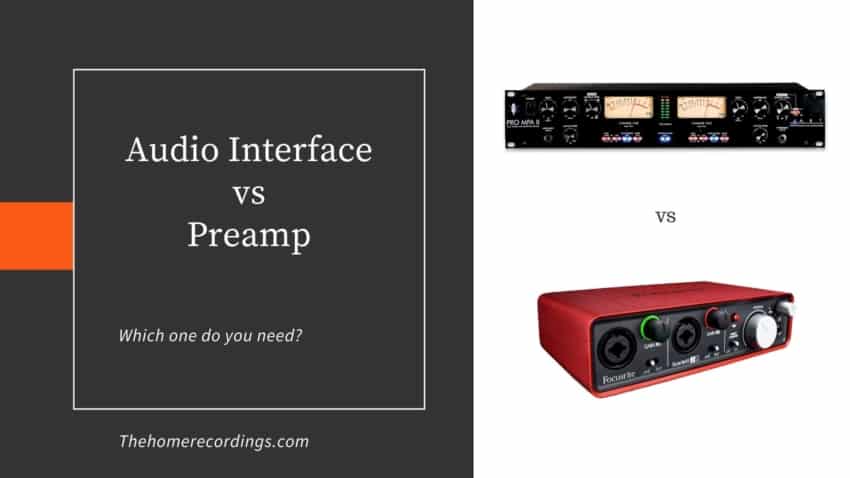Last updated on December 31st, 2023 at 06:01 pm
If you’re new to audio engineering, then you probably are a bit confused as to what an Audio Interface and a preamp are.
While they are fundamentally different, they need one another to be able to record music properly, and in this article I will tell you how they work, why you might need them, and if you actually need both of them (and which one to buy).
So, let’s get right to it!
Differences between an Audio Interface and a Preamp
A Preamp is designed to amplify low level audio signals, such as the one from a microphone, while an Audio Interface works by converting the analog audio signal into a digital format so that it can be recorded by the computer, essentially acting as a translator.
99% of audio interfaces available on the market today come with built-in preamps, meaning that an external/dedicated preamp won’t be needed.
However, preamps affect the quality of the audio and can also add character to it, and in some cases, you might want/need one depending on what kind of sound you’re going for.
To further understand the differences between the two and which one might suit your needs best, it’s important to know what each of them does and how they work.
So, let’s start with the preamp;
What is a Preamp?

A preamplifier is either the circuit within a device, such as a Microphone or Audio Interface, or it can also be a dedicated external device that has the same circuit in it, and it’s designed to raise the low signal level coming from a microphone to be able to be recorded properly, otherwise known as “line level”.
Some microphones, like the famous Shure SM7B, have such a low output that in order to get the signal to a respectable level you will need quite a powerful preamp.
In addition to this, using a high-quality preamp will not just provide you with a stable- higher-level signal, but it will also reduce unwanted noises, ending up in a much cleaner end product.
A mic preamp not only provides gain for the microphone’s signal, but it can also feed 48v phantom power to condenser microphones.
Why use a dedicated Preamp?
Preamps nowadays come in almost every piece of musical equipment on the market simply because of how useful they are, but you can also decide to purchase an external/dedicated one (Not needed for most people).
Microphones, mixers, Audio Interfaces, and other equipment all have built-in preamps.
However, in the more affordable range, these preamps may not be that great; an example would be the ones on the Behringer UM2 Audio Interface, since if you increase the gain on the preamp, it sounds distorted, even when the audio Is not clipping (digital distortion)
The main reason to use a dedicated preamp, and it’s also why they are used in high-end studios, is to get the best-sounding recording possible.
However, there is one other very important reason to using a preamp, and that is “audio coloration”; Preamps, especially tube/valve ones, will add character to the sound, and depending on the situation this might be exactly what your music needs.
Just know that a dedicated preamp can be extremely expensive and that it’s just one piece of the puzzle to get high-quality audio.
What Types of Preamps are there?
Note: I wrote an extensive article talking about what a preamp is and all the different ones available that you should definitely check out, but here’s a quick recap:
Tube Preamps
These preamps use Valves, or Vacuum tubes, to create Gain.
These will color the sound significantly since they aren’t “transparent” like some other preamps.
Tube Preamps are known for adding warmth especially to the mids, but also body to the bass and adding airiness to the highs.
This warmth is added when the signal increases, because tubes tend to distort the sound a bit but in a “pleasing” way. The circuit of a tube preamp also creates some slight compression, which adds color.
Solid State Preamps
Transistors are great at creating gain with less heat, which means that as the gain increases, they can maintain very low distortion until they reach the maximum level, at which point the distortion will be extremely noticeable.
This is also known as clipping.
Digital Preamps
Digital preamps take the analog signal and convert it to a digital signal, adding their own sonic flavor in the processing before the signal is sent to the DAW.
These preamps are useful because they allow you to bypass the Audio Interface’s built-in audio conversion which tends to be inferior (usually, although in most cases it’s not a problem).
Technically you could refer to these as Audio Interfaces, since they amplify the signal and also convert it to a digital format so that your PC can record it. BUT their main focus is on the preamp!
These are all Microphone specific preamps, but there are also Instrument specific ones available that are designed to optimize the tone of a specific instrument, such as Bass Guitar, Electric Guitar, etc.
Do you need an external preamp for a Home Studio?
Most likely not.
Anyone who is producing music from home can get excellent results with just a regular audio interface; of course, a super cheap one like the Behringer UM2 will definitely not be enough, but the Audient iD14 or Apollo Twin MKII series are absolutely fantastic and really do sound extremely professional.
Now, let’s have quick look at Audio Interfaces…
What is an Audio Interface?

Again, I wrote an entire article on what an Audio Interface is, but here’s a quick recap:
An Audio Interface is designed to convert the analog audio signal coming from your equipment into a digital one, which can then be recorded by the computer.
They come in all shapes and sizes, with a different number of inputs and outputs, as well as other features.
Like I mentioned in the beginning, Audio Interfaces also come with built-in preamps, which are usually controlled via a “Gain” knob, and this lets you manage the level of the audio signal as well as provide Phantom Power to condenser microphones.
Note: Anything that connects to a computer and lets you record audio is working as an Audio Interface, like for example USB microphones, portable recorders, etc.
Now, since most audio interfaces come with built-in preamps, here’s a very reasonable question…
Do you need a dedicated preamp if your Audio Interface already has preamps built in?
The answer in most cases would be a no, and here’s the reason behind it;
Most audio interfaces have surprisingly good-sounding preamps in them, and especially for home recording these audio interfaces are more than enough.
Getting an external preamp will be very expensive and you -most likely- won’t be able to tell the difference in the sound quality unless you have an exceptionally trained ear.
I would mostly recommend people who don’t run a super high-end studio to get a preamp ONLY if they want it to color the sound in a specific way, and even then, I don’t think it’s worth the money most of the time since there are other ways of accomplishing similar results.
How to connect an external preamp to an Audio Interface?

When using an external preamp, you don’t want to send that signal into the preamp of your Audio Interface since it kind of defeats the purpose of using a dedicated one in the first place.
So, what should you do instead?…
- Connect the microphone to the XLR Input on the external Preamp.
- Connect a cable either an XLR or TRS cable to the output of the Preamp.
- That same cable should be connected to the Line inputs on the Interface (usually on the back).
Lastly, here’s another important question that you might have…
What is a mixer and should you get one?
I wrote an extensive article comparing audio interfaces with mixers, and while they may share some similarities, they are designed to do two completely different things:
A Mixer does what its name implies; It mixes the incoming signals, adds processing and then sends the finished product to the speakers, or computer in some cases.
An Audio Interface simply translates the analog signal into a digital one so that it can be recorded on a digital system, such as a DAW on your computer.
Now, most mixers are designed with live sound in mind, and those can’t really be used that much in studios unless you use another audio interface in conjunction with them.
However, some mixers come with a built-in audio interface that lets you record all the individual channels of the mixer to the DAW, and not just the stereo output, like most live mixer would.
Of course, mixers also have built-in preamps for all the microphone inputs.
Now, should you get one?
This answer depends on your needs, but if you only need to record music in your home studio, then chances are that you will be better off getting a regular audio interface, mainly because of the price difference.
On the other hand, if you want to record your live shows, or if you like mixing using a mixing board instead of clicking with your mouse, then by all means, get one.
Which one to choose?
There are some preamps that can work as an Audio Interface, but the reality is that if you purchase a preamp, you will need to get an Audio interface in most cases, and this can be quite expensive only to improve the audio quality ever so slightly.
In 99% of the cases, don’t get a dedicated preamp, it’s simply not worth the extra cost.
I would recommend either a high-quality Audio Interface, like the Audient iD14, or mixers capable of doing multitrack recording.
Here are a couple articles that might help you find the best one for you:
Conclusion
While it may seem tempting to purchase a dedicated preamp, it’s generally not worth it since it won’t really affect the audio quality that much, especially if you have an audio interface with already great-sounding preamps.
Some modern Audio Interfaces, like the Audient ones, have extremely high-quality preamps in them, in fact, they are the same ones that Audient uses on their Studio-grade mixers.
So, unless you want one to add some flavor to your music, I wouldn’t recommend getting a dedicated preamp.
I hope this information was useful.
Have a nice day!

Wonderfully explained. Thanks for the effort in narrating it so beautifully. Thia article really helped me nail down my requirement.
Thanks.